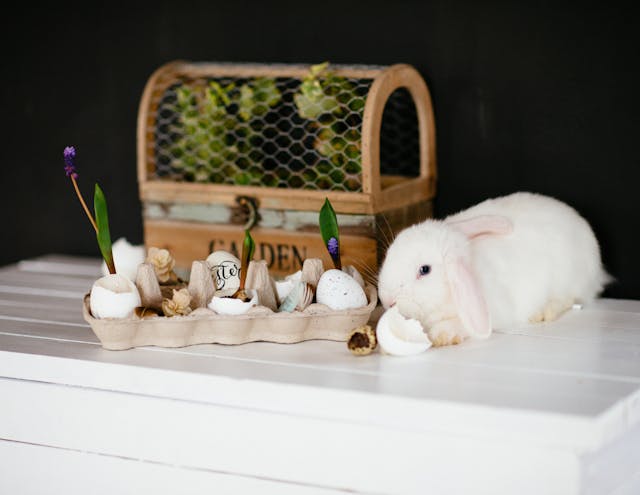How to Clean a Rabbit Litter Box

Do you know the relevance of keeping your rabbit litter box clean? Keeping your rabbit’s place of abode clean is not just about aesthetics it’s about ensuring your furry friend stays healthy, happy, and free from body odor. One of the most important parts of rabbit care is maintaining a sanitary litter box. By reading this post, you’ll learn from the expert tips on how to clean a rabbit litter box, what materials are safe, and how to prevent odor and infection, while keeping your pet’s environment as fresh as possible.
Why It’s Important to Keep a Rabbit Litter Box Clean
Rabbits are not like any other animals, like pigs or dogs, but they are known for their natural cleanliness. Nevertheless, a dirty litter box can lead to:
- Respiratory issues from ammonia buildup of your rabbits.
- Flystrike or parasitic infestations can easily lead to high mortalities.
- Urinary tract infections or any skin reactions.
- Behavioral problems due to stress or aversion as a result of dirt in their places.
Regular litter box cleaning not only helps in your rabbit’s health but also makes your home smell better and prevents your rabbit from rejecting the litter box.
Some of the Supplies You’ll Need to Clean Rabbit Litter Box
Before getting into the cleaning process, get the following in place:
- Disposable gloves
- White vinegar or pet-safe cleaner
- Scrub brush or sponge
- Unscented paper towels or microfiber cloth
- Fresh litter (paper-based, wood pellets, or hay)
- Trash bags or compost bin (if using biodegradable litter)
Expert Tip: Try to stop using ammonia-based cleaners because they can easily irritate your rabbit’s lungs.
Step-by-Step: How to Clean a Rabbit Litter Box
-
Remove Your Rabbit from the Box Safely
Remove it safely and place your rabbit in a safe playpen or a secure one, and monitor its movement. Doing this will help you to reduce stress as well as prevent accidents while you’re cleaning the litter box.
-
Dispose of Used Litter
Your next activity is to cautiously empty the soiled litter into a trash bag or compost bin. Don’t forget to use hand gloves to prevent contact with waste materials. If using eco-friendly litter like paper or hay, composting will be the best option for you.
-
Rinse the Litter Box
Rinse the litter box thoroughly with warm water to remove loose debris and soften dried stains. Avoid using boiling water in cleaning as it may warp plastic litter boxes.
-
Apply White Vinegar
Use White Vinegar to spray the inside of the litter box. Let it sit for 5-10 minutes. Vinegar naturally breaks down calcium and urine deposits that may affect the health of your furry.
Read More: S
-
Scrub Thoroughly
Scrub all the surfaces with a non-abrasive brush or sponge to avoid destroying the litter box. Look around the corners where urine often builds up and clean gently.
-
Rinse and Dry
Rinse thoroughly with warm water to kill germs or anything you cannot see with your eye. Dry with paper towels or allow to air-dry before refilling.
-
Add Fresh Litter to the old one or replace it
Place a layer of fresh litter (1-2 inches thick) into the box to make it conducive. You can also add a bit of hay on top, especially if your rabbit likes to snack while doing their business.
Read More: Simple Ways to Clean a Rabbit
-
Return the Box and Your Rabbit
Once the box is clean and dry, return it to your rabbits. Watch for signs of satisfaction most rabbits will hop right in!
How Often Should You Clean a Rabbit Litter Box?
- Spot Clean Daily: Remove heavily soiled litter and feces once or twice a day.
- Deep Clean Weekly: Disinfect the entire litter box at least once a week.
- Multiple Rabbits: Increase cleaning frequency based on the number of rabbits and size of the litter box.
Expert Tip: Having two litter boxes and rotating them helps maintain hygiene with less stress.
Odor Control Tips
- Use odor-neutralizing litter (unscented only).
- Add a few drops of apple cider vinegar to your rabbit’s water to reduce urine smell (consult your vet first).
- Consider a litter box with a high back to prevent spills.
- Place a baking soda sachet nearby (but not inside the box).
What to Avoid When Cleaning the Litter Box
- Scented Cleaners: Rabbits are sensitive to artificial scents and chemicals so avoid using chemicals with high scents.
- Clumping Clay Litter: It’s harmful if downed and can cause respiratory health issues.
- Bleach Without Dilution: Only use heavily diluted bleach and rinse thoroughly afterward.
Choosing the Best Litter for Easy Cleaning
- Paper-Based Litter: Highly absorbent and easy to compost.
- Wood Pellets: Excellent for odor control.
- Hay: Good for encouraging litter box use but not very absorbent, so it must be layered on top of absorbent material.
Eco Tip: Biodegradable litter options are not only safe but help reduce landfill waste.
When to Replace the Litter Box
Even with good maintenance, litter boxes wear out as time goes on and require replacing them. Replace your rabbit’s litter box every 6-12 months, especially if it becomes scratched, cracked, or permanently stained.
Conclusion
Knowing how to clean a rabbit litter box is one of the initial habits of responsible rabbit care, and you must be in known. Cleanliness ensures not only your pet’s health but also a smell-free and more hygienic home environment. With regular upkeep, safe cleaning products, and high-quality litter, your rabbit will have a comfortable and sanitary space to do their business. Don’t cut corners your bunny will thank you!

